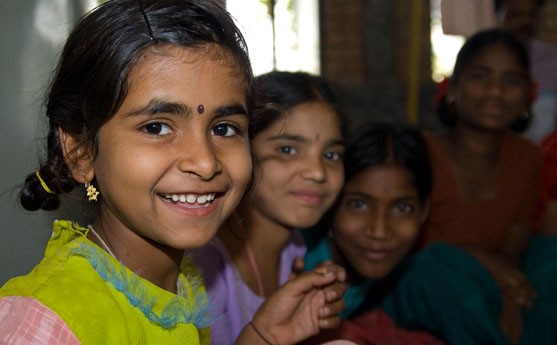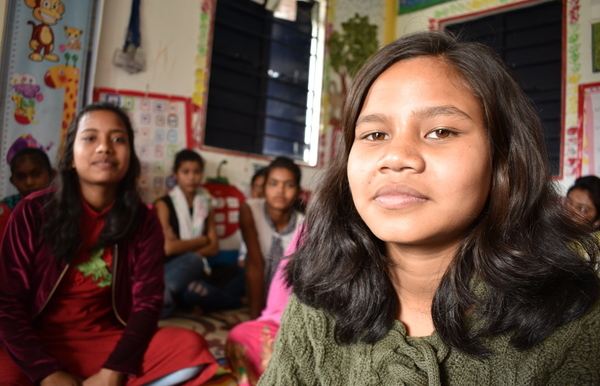

Overview
Poor, rural girls in West Bengal, India face a host of vulnerabilities that threaten their social and economic wellbeing. These include extreme poverty, malnutrition, gender-based violence, lack of education, trafficking, and child marriage. According to UNICEF:
- 1By age 15, one girl out of every five in West Bengal is married. More than one quarter of girls are married to men who are ten or more years older.
- 2Almost half of all rural girls are pregnant by age 19.
This has devastating consequences for the girls, who leave school early to marry and often experience serious health problems during and after their early pregnancy. Likewise, their children are often born small and underweight. These young, uneducated girls are less likely to be able to support their children, less likely to immunize their children, and less likely to educate their children.
Numerous factors play a role in creating girls’ vulnerabilities, but two in particular are at the heart of the Girls Project. One is how families and communities perceive a girl’s value. Another is stark economic reality. The issue of child marriage illustrates how these factors converge to the detriment of girls. In West Bengal and throughout other areas in India, girls are often perceived as burdens by their families because they are not seen as financial contributors and because their families must pay dowry to have them married. The cost of dowry can devastate a family financially, so many families do what they can to avoid paying a large dowry. In many cases, this means marrying a girl off so young, even at 12 or 14 years old. By tradition, if a bride is very young, dowry is sometimes reduced or not required. Once married, girls usually have to drop out of school.
The Girls Project
In 2010, Landesa launched the Security for Girls Through Land Project (Girls Project), which aims to improve girls’ social and economic status, and thereby reduce their many vulnerabilities in the short and long-term. By increasing girls’ and communities’ understanding of girls’ land-related rights and helping girls to use land to create assets and demonstrate their value, girls can gain some control over their futures and are more likely to enjoy secure land rights as adults.
The project was implemented in partnership with West Bengal’s Department of Women and Child Development (WCD), which, along with several other states, is piloting the Rajiv Gandhi Scheme for Empowerment of Adolescent Girls (SABLA). SABLA is a government-funded program that has a goal of empowering adolescent girls by providing them with life and vocational skills and improving their health and nutritional status.
Landesa has added a curriculum on land rights, asset creation, and land-based livelihoods for adolescent girls to the SABLA curriculum. The project’s main components are:
Girls’ groups: teaching girls about land rights, assets, and land-based livelihoods
“Girls’ groups,” facilitated by peer-leaders with support from community health workers, meet regularly for interactive discussions and lessons designed to help girls understand land rights, the benefits of having control over and access to land, and the importance of equal inheritance rights for boys and girls. These groups also provide the girls with land-based livelihood skills and practical knowledge of how to access government institutions that can help them claim their inheritance and secure their land rights in the future.
Hands-on activities focus on teaching the girls to cultivate small “kitchen gardens” with nutritious produce that they can add to their family’s food supply or sell for income. Many girls use their gardens to earn money for the first time, and their families are beginning to see them as assets rather than burdens.
Girls’ families are delaying their marriage and some girls have used their new savings to return to school. In addition to the discussions on land rights and land based livelihoods, girls learn about health, nutrition and various aspects of their own empowerment.
Boys’ education and community engagement: sensitizing boys and communities to girls’ vulnerabilities and rights and the benefits of their connection to land
Based on the understanding that social and economic improvements for girls will only be sustainable when community perceptions of girls are changed, the project includes activities aimed at increasing understanding of girls’ rights, the benefits of their connection to land, and the causes and effects of their vulnerabilities.
Activities include a curriculum for boys, which is being rolled out at local schools and meetings with village leaders and other community members, including parents, to discuss various aspects of empowerment of adolescent girls and to initiate the process of changing mindsets and creating an environment in which girls’ economic and social empowerment can take root and endure.
Our Impact
 The Girls Project reached more than 40,000 girls in more than 1,000 villages in the Cooch Behar district of West Bengal. Girls who participated in the program for one year were more likely to continue their studies, more likely to have an asset in their name, and less likely to become a child bride.
The Girls Project reached more than 40,000 girls in more than 1,000 villages in the Cooch Behar district of West Bengal. Girls who participated in the program for one year were more likely to continue their studies, more likely to have an asset in their name, and less likely to become a child bride.
Related Links:
- Watch and share Academy Award®-winning filmmaker Megan Mylan’s short documentary film about the project.
- A photo essay telling the story of five girls participating in the project
- 5 challenges for girls in India
- 10 ways land rights make a difference
- 10 reasons to invest in girls
- 5 things you can do to support land rights
- Read the rigorous evaluation report of the program’s impact.
- Download the PDF fact sheet for the project.
- Girls and Land: A Briefer on the Girls Project (June 2018)
